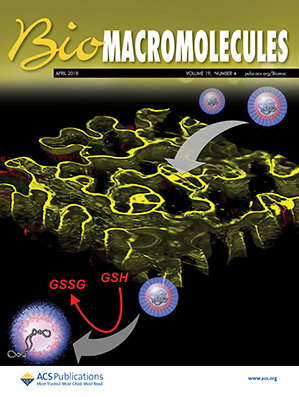高分子量壳聚糖在水溶液中的强疏水相互作用。
IF 5.4
2区 化学
Q1 BIOCHEMISTRY & MOLECULAR BIOLOGY
引用次数: 0
摘要
壳聚糖是一种用途广泛的生物活性多糖,具有丰富的生物可降解性、生物相容性和抗菌性,在制药和环境等行业中有着广泛的应用。为了有效地利用其各种用途的潜力,了解其在水中相互作用的机制至关重要。本研究利用表面力仪(SFA)研究了高分子量(HMW, > 150kda)壳聚糖与三种不同ph值(3.0,6.5和8.5)下四种不同功能化自组装单层(SAMs)之间的相互作用。我们报告说,HMW壳聚糖在所有ph值上都与甲基端SAM (CH3-SAM)具有最强的粘附力,显示出与其他含有疏水部分的分子具有强疏水相互作用的潜力。氢键一直被认为是壳聚糖的主要相互作用机制,本研究结果为其在壳聚糖基环保材料开发中的应用提供了有价值的见解。本文章由计算机程序翻译,如有差异,请以英文原文为准。
Strong Hydrophobic Interaction of High Molecular Weight Chitosan in Aqueous Solution
Chitosan is a versatile bioactive polysaccharide in various industries, such as pharmaceuticals and environmental applications, owing to its abundance, biodegradability, biocompatibility, and antibacterial properties. To effectively harness its potential for various purposes, it is crucial to understand the mechanisms of its interaction in water. This study investigates the interactions between high molecular weight (HMW, >150 kDa) chitosan and four different functionalized self-assembled monolayers (SAMs) at three different pHs (3.0, 6.5, and 8.5) using a surface forces apparatus (SFA). We report that HMW chitosan exhibits the strongest adhesion to methyl-terminated SAM (CH3–SAM) at all pHs, showing potential for strong hydrophobic interactions against other molecules containing hydrophobic moieties. Noting that hydrogen bonding has been considered the dominating interaction mechanism of chitosan, the consequence of this study provides valuable insights into its applications in developing chitosan-based eco-friendly materials.
- Download: Download high-res image (142KB)
- Download: Download full-size image
求助全文
通过发布文献求助,成功后即可免费获取论文全文。
去求助
来源期刊

Biomacromolecules
化学-高分子科学
CiteScore
10.60
自引率
4.80%
发文量
417
审稿时长
1.6 months
期刊介绍:
Biomacromolecules is a leading forum for the dissemination of cutting-edge research at the interface of polymer science and biology. Submissions to Biomacromolecules should contain strong elements of innovation in terms of macromolecular design, synthesis and characterization, or in the application of polymer materials to biology and medicine.
Topics covered by Biomacromolecules include, but are not exclusively limited to: sustainable polymers, polymers based on natural and renewable resources, degradable polymers, polymer conjugates, polymeric drugs, polymers in biocatalysis, biomacromolecular assembly, biomimetic polymers, polymer-biomineral hybrids, biomimetic-polymer processing, polymer recycling, bioactive polymer surfaces, original polymer design for biomedical applications such as immunotherapy, drug delivery, gene delivery, antimicrobial applications, diagnostic imaging and biosensing, polymers in tissue engineering and regenerative medicine, polymeric scaffolds and hydrogels for cell culture and delivery.
 求助内容:
求助内容: 应助结果提醒方式:
应助结果提醒方式:


